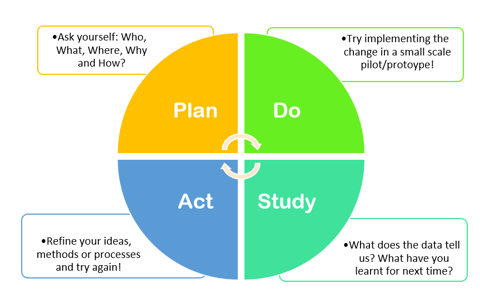
Model for Improvement and PDSA Cycles
The ‘Model for Improvement’ is a national framework to help with structuring your project. It consists of 2 parts, initially there are 3 questions followed by a PDSA cycle.
Part 1
The Framework:
What are we trying to accomplish?
To answer this question - try to define your problem and turn it into an aim that is SMART (Specific, Measurable, Achievable, Reasonable and Timely). You need a SMART aim to be able to demonstrate a change over time.
The Engine:
How will we know that a change is an improvement?
There are 3 types of measurement within a quality improvement project: outcome, process and balance.
Outcome Measures:
The outcome measure is often directly linked to the aim. Try to answer these questions to identify your outcome measures:
How does the system impact the values of patients, their health and wellbeing?
What are the impacts on other stakeholders such as payers, employees or the community?
Process Measures:
Your improvement project will involve changing or modifying different processes or systems to hopefully improve the problem that you’ve identified. It is important to measure the reliability of any process changes so you can track them against the aim:
Try to answer these questions to identify your process measures:
Are the parts/steps in the system performing as planned?
Are we on track in our efforts to improve the system?
Balancing Measures:
It is important to understand whether any negative effects have occurred as a result of your change. By identifying the balancing measures you may show whether any unintended consequences have been introduced elsewhere in the system.
Try to answer this question:
Are changes designed to improve one part of the system causing new problems in another part of the system?
Each project should have approximately 5-8 measurements.
What changes can we make that result in improvement?
Utilising your driver diagrams, force field analysis and/or step back process you can identify a wealth of potential changes for your project. You do not need to undertake every single change that has been identified however you should be able to identify a selection of reasonable changes that can be tried to achieve your aim.
Part 2:
PDSA Cycles
The concept of a PDSA cycle is relatively simple in that you plan a change, enact (do) a change, study the effects of the change and then act on what has been achieved. You may decide to do PDSA cycles looking at each change individually over consecutive time periods or multiple PDSA cycles simultaneously. Record your PDSA cycles over time to demonstrate the improvement journey which is often lost and not recorded.
Plan:
Define the objective, questions and preductions.
Who? What? Where? When?
What data do you need to collect to answer these questions? Remember that you do not need to collect large data samples to prove a problem exists and show effective change. Do you need patient demographic data or not? Will it have any bearing on the results.
Do:
Carry out your plan for change. Start to collect data to show the effects of the change.
Study:
Analyse your data collection following the implementation of your change idea. Remember the data sample does not need to be exhaustive. Compare the analysis of the data to your original predictions. Summarise what effects have happened.
Act:
What changes are needed in the next PDSA cycle? How much of the aim has been achieved? Was your change successful and can it be implemented long term?
Following an initial PDSA cycle you would then repeat further PDSA cycles to reach your intended aim. If the change is successful then you work to keep the change embedded in practice. If the change is not successful or detrimental then you may need to decide if a return to the pre-change state is needed and how this can be implemented.




